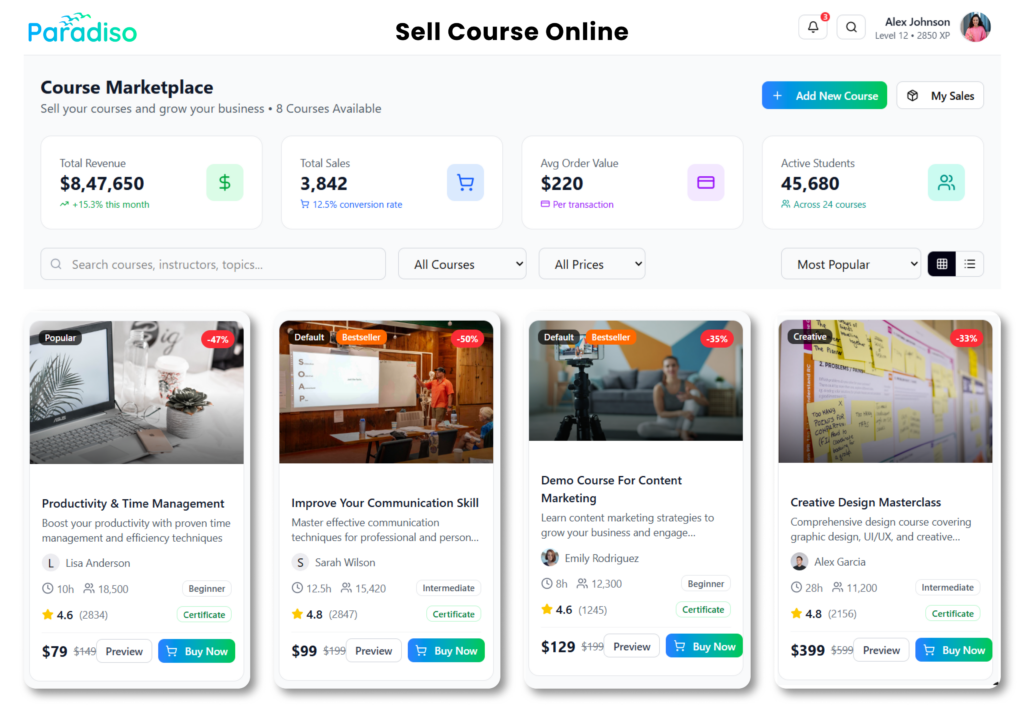Your association is all about people, especially its members. They are the ones who make your association thrive. But behind the scenes, technology plays a significant role in helping you succeed. Associations rely on different types of technology to make money, keep track of memberships, and build a strong community. Two crucial pieces of technology are association management systems (AMS) and learning management systems (LMS). AMS helps you manage member information, keep track of membership fees, and communicate with members. LMS, on the other hand, stores online educational materials.
Both AMS and LMS are vital for your association’s success. They can do a lot on their own, but they work even better when they are connected. LMS-AMS integration has many benefits for efficient association management. It helps you work smarter, saves time, and improves how you serve your members.
Why is AMS-LMS Integration Essential?
Before we dive into the common integration points, let’s explore why you would want to connect an LMS and an AMS in the first place.
The main reason is that the AMS serves as the central database for a membership organization. It holds vital contact information and tracks members’ interactions, like when they joined, renewed their membership, made purchases, and their interests. Instead of requiring users to create separate accounts for each software system, it’s simpler if other systems can utilize the information already stored in the AMS, such as their name and email address. Otherwise, you may have multiple records for the same member, leading to confusion and headaches.
In many cases, other software applications like content management or email marketing system are already integrated with the AMS, making it the hub for member activities. Integrating an LMS adds a new dimension to this hub. Once integrated, the LMS can check with the AMS to determine if a prospective user is a member and adjust accordingly. It can automatically assign relevant courses or apply discounts if the LMS handles e-commerce. Additionally, it can share information back to the AMS, such as earned continuing education units, allowing the AMS to maintain a comprehensive view of member data.
Integration’s benefits include a seamless user experience, eliminating the need for multiple logins or contacting staff for credit reporting. Integration reduces support issues for organizations and provides a centralized location to access essential member data.
However, there may be situations where integration is optional. For example, if education functions independently as a standalone business, there may be no need to link the AMS and LMS. Occasionally, internal divisions, politics, or cultural factors can prompt the education department to adopt a separate system that handles all aspects of the education business, including e-commerce. While not necessarily recommended, this approach does occur in some instances.
Essential Key Points of Integrating AMS-LMS Integration
AMS-LMS: Single Sign-On
Single sign-on (SSO) is an excellent feature that makes your life easier when accessing online courses or content. Imagine this: you’re already logged in to your favorite website and want to check out some courses on a different platform. With SSO, you don’t need to go through the hassle of logging in again. It’s like having a magic key that opens multiple doors without needing different keys.
Here’s how it works. You log in to the main website of an organization. That website has a unique AMS database that stores information about users like you. When you want to access the learning management system (LMS) to take courses, SSO comes into action. You click the link or button to go to the LMS; you don’t need to enter your login details again. The system automatically checks the information you provided on the main website with what’s in the AMS database.
If everything matches up and the AMS confirms that you have permission to use the LMS, it sends a message back to the LMS, saying, “Let them in!” Then, like magic, you’re taken directly to the page you wanted to reach in the LMS. It all happens super-fast, usually in just a few seconds. You don’t even notice the behind-the-scenes stuff going on.
But what if you don’t have permission or the AMS doesn’t recognize you? Don’t worry; you won’t get stuck. You’ll be redirected to a page that tells you what to do next to gain access. The system has got your back!
AMS-LMS: E-commerce Integration
When associations use a learning management system (LMS), they usually want to sell access to their courses. They might already have an e-commerce system for selling memberships, event registrations, etc. Now the question is, should they use the existing e-commerce system or the built-in e-commerce system of the LMS?
No matter which e-commerce system they choose, integration is essential. If purchases happen in the existing system, the LMS must be informed so that users can access the courses they bought. Ideally, users should get immediate access to on-demand courses right after purchase. With e-commerce integration, the existing system can automatically notify the LMS about the new courses, usually when the user next accesses the LMS. Another option is to update the LMS database with further course purchase information at specific times, like every night.
If the LMS provides e-commerce functionality, the association still needs their primary system (AMS) to know about the purchases. They might want to keep a record of the courses a member bought and track their earned credits. While the LMS captures this data, sharing it with the AMS for reporting is helpful. It can be done through web services or a batch process, where information is regularly shared from the LMS to the AMS.
Lastly, integrating the e-commerce system with the LMS ensures that course purchases are adequately recognized, granting users access to their courses. It also allows for a comprehensive record of member purchases and credit tracking, benefiting both the LMS and the leading association system.
AMS-LMS: Learner Data Integration
When you use an LMS, it collects data about your activities, like how much time you spend on courses and your scores. It’s helpful for the primary association system (AMS) to have some of this data, especially regarding completed courses and certificates. The LMS and AMS can exchange this data in real time or through regular updates.
Many LMS companies have experience integrating with popular AMS systems. They offer user-friendly interfaces and tools to manage the integration process. AMS companies also support integration and have programs to help third-party integrators. They use web services or APIs to connect their platforms with other systems.
However, consider a few things before integrating an LMS and an AMS:
Are the vendors prepared for integration? Check if they have detailed documentation explaining the integration process.
Have they done integrations before? Experience with similar systems is valuable. Ask for references.
Are there internal issues that could hinder integration? Ensure everyone is aligned on goals and technical requirements, and gain support from leadership and stakeholders.
Lastly, integrating an LMS and an AMS requires careful consideration. Ensure the vendors are ready for integration, have relevant experience, and address internal challenges. It’s essential to have a clear vision, technical alignment, and support from key stakeholders before starting the integration process.
Top 3 Key Methods to Determine AMS Feature Priorities when Evaluating an LMS
Step One: Assess the Capabilities of Your Current AMS
If your current system (AMS) can’t handle important tasks like managing data, analyzing information, and generating reports effectively, there may be better choices than a primary learning system (LMS). To understand why, think about the kind of information you need. For example:
- Can your system show educational outcomes for different learner groups?
- Can it track how members respond to emails over time?
- Does it provide website usage data and support requests?
- Can it compare member polls with marketing campaign responses?
- Can it analyze learner quiz results and satisfaction data by location, education level, and demographics?
These insights are crucial for making informed decisions. If your system doesn’t offer easy access to this information, consider an advanced LMS like Paradiso LMS. Their powerful analytics, automation features, and efficient reporting flawlessly integrate with your existing system, providing you with the valuable data you need.
Step Two: Consider Few Things to Look for LMS-AMS Integration
A. Accessibility of Data Transparency:
B. Manage Multiple Administrative Tasks:
C. Efficient and Smooth Communications:
Step Three: Take a Test through LMS-AMS Integration
The process becomes simple once you use a robust learning management system (LMS) like Paradiso LMS. Our integration services can effortlessly connect your current AMS with our platform, sparing you from dealing with the technical aspects. When integrated LMS into AMS, you’ll easily access various convenient features.
A. Paradiso LMS Powerful Analytics:
B. Cutting-edge User Engagement Tools:
You’ll receive immediate personalized feedback when taking quizzes or tests. This feedback can come after each question or at the end of the assessment. Assessments may include videos, animations, audio, or visual elements to make learning more interactive and enjoyable. Additionally, you can set up reminders for follow-up assessments to stay on track with your learning progress and continuously improve your knowledge.
C. Manage users effortlessly with Paradiso LMS:
5 Best Practices for LMS-AMS Integration That Enhances Member Experience
Associations can help their members learn and grow professionally through continuing education courses. When an association LMS integrates with its AMS systems, it becomes easier to keep track of members’ progress and support their learning journey.
By offering these educational opportunities, associations create an engaging environment that encourages members to participate and make the most of what the association provides. Today, let’s explore how associations and their members can benefit from an integrated LMS and AMS.
To provide the best learning experiences, associations should choose a flexible LMS that can adapt to members’ unique needs. This way, they can create personalized learning experiences that help members thrive and succeed within the association.
With AMS-LMS integration, associations can streamline learning processes, track progress, and ensure members receive the support they need to excel in their professional development.
A. Select an LMS that positions you as the focal point for member learning.
Your association should provide courses and materials that meet your members’ professional needs. Choose a learning system (LMS) that lets you track their ongoing education, even if they learn outside your association.
Your members already use your system (AMS) to connect with others, register for events, and engage with your association. Now, your goal is to be their go-to source for lifelong education. Members can see their entire education history when your AMS and LMS work together.
They can track their education using these features:
- Learning through self-reporting: Your LMS should let members report education and credits earned outside your systems. By offering this, you become their primary source for tracking education.
- Migrating Existing Education Records: If you switch to a new LMS, make sure you can transfer members’ existing records into the new system.
- The Value of a Comprehensive Education Transcript: Professionals need a transcript that tracks their education. Boards and employers usually require a three-year history for monitoring education.
B. Assist your members in showcasing their accomplishments in their profiles.
Your members’ profiles in your Association Management Software (AMS) are essential for connecting with professionals. They show their certifications and areas of expertise. Members can display their completed courses on their profiles when Integrated LMS and AMS work together.
To make it easy for members, your AMS should let them show their achievements with badges or symbols on their profiles. It helps others learn about their certifications and specialties.
Updated member profiles from your LMS help you and your teams understand members better. You can see their goals, interests, and:
- Certifications: Some fields, like healthcare, require certificates for professional growth. Showing certifications on profiles is essential for members’ professional reputations.
- Course completions: Knowing which courses members finished helps you create future courses they’ll like and recommend suitable ones to other members based on their interests.
With AMS-LMS integration, you improve member profiles and understand their needs and accomplishments more effectively.
C. Deliver Collaborative Learning opportunities for Your Members
Social learning is when members learn from each other by sharing their ideas and perspectives on course materials. It’s like having a study group where everyone brings their unique expertise. You can make the most of social learning for your members using your integrated LMS and AMS systems.
Social learning can happen online or in person. It keeps members engaged and suits different learning styles. With your AMS systems, you can offer social learning through:
- Live chats: Online learners can have real-time discussions with other course members, like talking in a classroom. It helps them see different viewpoints and remember what they learn.
- Live education meetings: Find an LMS that lets you host in-person learning events for members in the same area. You can also turn the event materials into online resources for remote learners.
By encouraging social learning, you create an interactive environment where members learn from each other and gain a deeper understanding of the course materials.
D. Members' Learning Opportunities with Course Suggestions via Your AMS.
Your AMS systems contain valuable information about your members’ professional achievements and goals, especially within their profiles. You can utilize this information to provide personalized course recommendations through your Learning Management System (LMS).
By leveraging your member database, you can enhance your members’ professional growth by offering them the most relevant continuing education courses. These recommendations can be based on the following:
- Past course completions: Members often want to develop or enhance their skills through related courses. Recommendations based on their previous course completion within your LMS are highly appreciated and effective.
- Peers’ course completions: As professional expectations evolve; specific courses may become popular among your members. Recommendations based on what their peers have completed can also be precious.
Using your AMS insights, you can provide tailored course recommendations that align with your members’ interests and goals. This personalized approach enhances their professional development and ensures access to relevant and valuable courses.
E. Ensure Your Members Stay Informed About Other Learning Possibilities.
Your association members highly value the insights and growth opportunities your association provides. They want to learn as much as possible and maximize their membership. Inform your members through your AMS systems and association website whenever you introduce new courses or offer more ways to learn and grow.
Helping your members learn and achieve their professional goals is vital to your association’s identity. So, it’s essential to highlight learning opportunities on all platforms you use to communicate with members. It includes:
Interactions through AMS systems: AMS systems let you send all members automated messages about new courses. You can also target specific groups with relevant course information.
Association website: Ensure your website showcases the professional development opportunities you provide, including on-demand courses. It encourages current members to sign up and attracts potential members to join.
Promoting learning opportunities empowers members to grow and succeed through your association.
Conclusion
Paradiso LMS has changed how associations grow sustainably and efficiently. You don’t need to burden your association management system (AMS) with tasks better suited for an enterprise-grade learning management system (LMS). With Paradiso LMS, you gain an instant partner for technical support and content development, helping your association achieve its service goals.
It understands the importance of membership management for associations and the demand for high-quality content to share globally. They offer engaging content options, including gamified mobile content, simulations, and interactive films. With millions of users worldwide, It is known for its adaptability, user-friendliness, comprehensiveness, and proven results. It’s a time and cost-saving solution that can benefit your organization.
Contact Paradiso LMS for a free demo call or visit our website to experience the advantages of LMS-AMS integration. They are eager to showcase how their platform can enhance your association’s operations.
Efficient Course Creation and Management
Paradiso LMS provides trainers with user-friendly tools to create and manage training courses. You can easily upload and organize course materials, including presentations, videos, documents, and quizzes. This streamlines the course development process and allows you to focus more on delivering effective training content.














